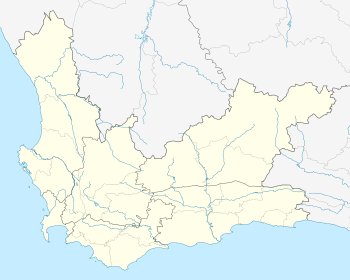Romansrivier
Romansrivier,[2] in Ward 2 Dwarsrivier,[3] is a settlement in Witzenberg Local Municipality, Cape Winelands District Municipality, Western Cape province, South Africa. It is in the upper Breede River Valley region. Rte. 43 (Michell's Pass Road) runs north-south past the settlement. The Romanrivier railway station is located just south of the settlement. The Witteberg Nature Reserve is just east of the settlement.
Romansrivier Dwarsrivier | |
|---|---|
 Romansrivier  Romansrivier | |
| Coordinates: 33°28′08″S 19°12′51″E | |
| Country | South Africa |
| Province | Western Cape |
| District | Cape Winelands |
| Municipality | Witzenberg |
| Area | |
| • Total | 0.09 km2 (0.03 sq mi) |
| Elevation | 460 m (1,510 ft) |
| Population (2001)[1] | |
| • Total | 506 |
| • Density | 5,600/km2 (15,000/sq mi) |
| Time zone | UTC+2 (SAST) |
| Postal code (street) | 0812 |
| PO box | 0812 |
History
When the Dutch arrived in the Dwarsrivier area it was inhabited by the San people (Bushmen). Dutch "Free Burghers" (vryburgers) first settled there in 1687.[4]
Notes and references
- "Sub Place Dwarsrivier #10611001". Census 2001.
- Romansrivier (Approved - N) at GEOnet Names Server, United States National Geospatial-Intelligence Agency
- "Witzenberg Overview Map". Municipal Demarcation Board. Archived from the original on 14 October 2018.
- "History of the Dwarsrivier River Valley". Dwarsrivier Valley Tourism. Archived from the original on 13 October 2018.
gollark: --tel hangup
gollark: Um. Oh no.
gollark: --apiotel status
gollark: <@!332271551481118732>
gollark: You can only dial out to one channel at once for reasons I forgot.
External links
- "About Dwarsrivier". Dwarsrivier Valley Tourism.
This article is issued from Wikipedia. The text is licensed under Creative Commons - Attribution - Sharealike. Additional terms may apply for the media files.
.svg.png)